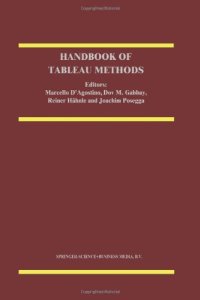
Ebook: Handbook of tableau methods
Author: Melvin Fitting (auth.) Marcello D’Agostino Dov M. Gabbay Reiner Hähnle Joachim Posegga (eds.)
- Tags: Logic, Mathematical Logic and Foundations, Symbolic and Algebraic Manipulation, Artificial Intelligence (incl. Robotics)
- Year: 1999
- Publisher: Springer Netherlands
- Edition: 1
- Language: English
- djvu
Recent years have been blessed with an abundance of logical systems, arising from a multitude of applications. A logic can be characterised in many different ways. Traditionally, a logic is presented via the following three components: 1. an intuitive non-formal motivation, perhaps tie it in to some application area 2. a semantical interpretation 3. a proof theoretical formulation. There are several types of proof theoretical methodologies, Hilbert style, Gentzen style, goal directed style, labelled deductive system style, and so on. The tableau methodology, invented in the 1950s by Beth and Hintikka and later per fected by Smullyan and Fitting, is today one of the most popular, since it appears to bring together the proof-theoretical and the semantical approaches to the pre of a logical system and is also very intuitive. In many universities it is sentation the style first taught to students. Recently interest in tableaux has become more widespread and a community crystallised around the subject. An annual tableaux conference is being held and proceedings are published. The present volume is a Handbook a/Tableaux pre senting to the community a wide coverage of tableaux systems for a variety of logics. It is written by active members of the community and brings the reader up to frontline research. It will be of interest to any formal logician from any area.
The tableau methodology, invented in the 1950's by Beth and Hintikka and later perfected by Smullyan and Fitting, is today one of the most popular proof theoretical methodologies. Firstly because it is a very intuitive tool, and secondly because it appears to bring together the proof-theoretical and the semantical approaches to the presentation of a logical system.
The increasing demand for improved tableau methods for various logics is mainly prompted by extensive applications of logic in computer science, artificial intelligence and logic programming, as well as its use as a means of conceptual analysis in mathematics, philosophy, linguistics and in the social sciences.
In the last few years the renewed interest in the method of analytic tableaux has generated a plethora of new results, in classical as well as non-classical logics.
On the one hand, recent advances in tableau-based theorem proving have drawn attention to tableaux as a powerful deduction method for classical first-order logic, in particular for non-clausal formulas accommodating equality.
On the other hand, there is a growing need for a diversity of non-classical logics which can serve various applications, and for algorithmic presentations of these logicas in a unifying framework which can support (or suggest) a meaningful semantic interpretation.
From this point of view, the methodology of analytic tableaux seems to be most suitable. Therefore, renewed research activity is being devoted to investigating tableau systems for intuitionistic, modal, temporal and many-valued logics, as well as for new families of logics, such as non-monotonic and substructural logics.
The results require systematisation. This Handbook is the first to provide such a systematisation of this expanding field. It contains several chapters on the use of tableaux methods in classical logic, but also contains extensive discussions on:
- the uses of the methodology in intuitionistic logics
- modal and temporal logics
- substructural logics, nonmonotonic and many-valued logics
- the implementation of semantic tableaux
- a bibliography on analytic tableaux theorem proving.
The result is a solid reference work to be used by students and researchers in Computer Science, Artificial Intelligence, Mathematics, Philosophy, Cognitive Sciences, Legal Studies, Linguistics, Engineering and all the areas, whether theoretical or applied, in which the algorithmic aspects of logical deduction play a role